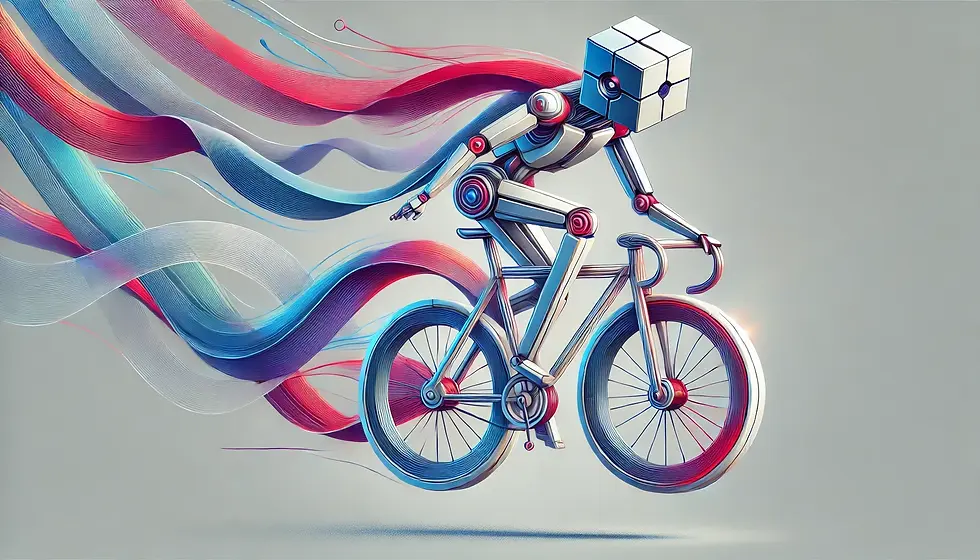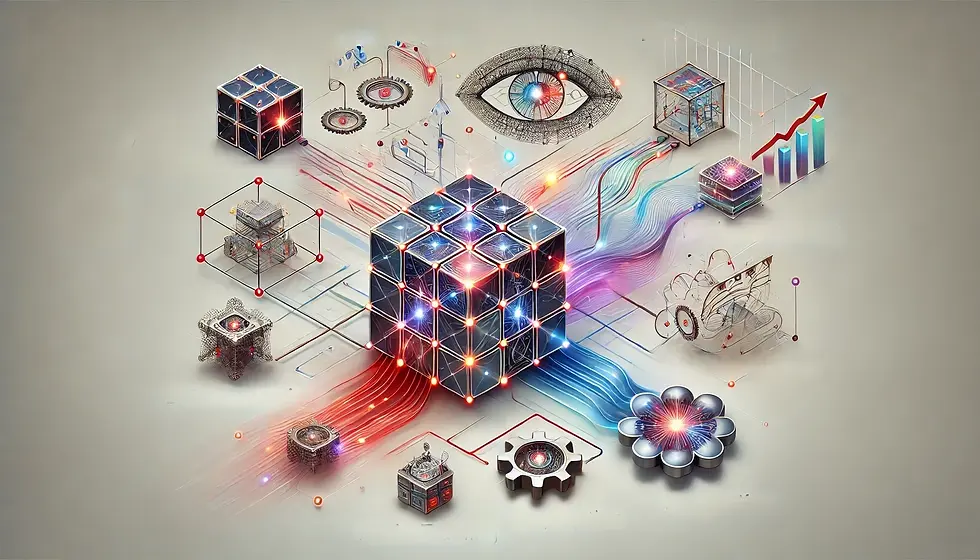How AI-Powered Automation is Transforming Industries and Unlocking New Opportunities
- Silvia

- Jan 8
- 5 min read
Updated: Apr 4
Introduction
Picture a world where routine, time-consuming tasks are seamlessly handled by AI, giving you the freedom to focus on strategy, innovation, and business growth. This isn’t a futuristic dream—it’s happening right now as businesses harness AI-powered automation to streamline operations and boost efficiency.

But let’s be honest—AI can seem overwhelming. Maybe it feels too complex, too expensive, or even too "out there" for your business. Yet, the truth is, AI-powered automation is already proving its worth across industries. It’s not just a buzzword; it’s a game-changer that can streamline workflows, reduce costs, and open doors to innovation.
This guide will walk you through what AI-powered automation is, how it works, and why it’s worth exploring. Want to explore more AI trends?
Check out our guide on AI-driven business strategies for deeper insights. You’ll see real-world examples of businesses using AI to their advantage and discover how you, too, can embrace its potential.
AI-Powered Automation
What It Is & Why It Matters
AI-powered automation leverages technologies like machine learning, natural language processing (NLP), and robotic process automation (RPA) to complete tasks with minimal human involvement. Unlike traditional automation, AI doesn’t just follow rules—it learns, adapts, and optimizes processes over time. It’s not just about following rules; it’s about systems that can learn, adapt, and make decisions intelligently.
Think of it like having a supercharged assistant that not only handles your tasks but improves at doing them over time. For example, an AI-powered tool can sift through invoices, extract key data, and send approvals without a single email or spreadsheet error.
The result? You save time, reduce mistakes, and free up your team for the creative, strategic work that matters most.
How AI Workflow Optimization is Changing Business

Traditional Automation vs. AI-Powered Automation
Traditional Automation: Great for repetitive tasks but rigid—if the task changes, the system can’t adapt.
AI-Powered Automation: Learns and evolves. It’s like having a dynamic problem solver working behind the scenes.
For instance, while traditional automation might send the same email to everyone, AI-powered systems personalize those emails based on customer behavior, boosting engagement and conversions.
Where AI is Making the Biggest Impact
Workflow Optimization: Tools like UiPath streamline repetitive tasks like data entry or scheduling.
Cognitive Automation: AI mimics human reasoning to make decisions, like approving loans or diagnosing medical conditions.
This isn’t just technology for technology’s sake—it’s a way to take your operations to the next level.
Why Businesses Are Embracing AI-Powered Automation for Growth
AI-powered automation is more than a tool, it’s an opportunity to work smarter, not harder. Here’s why businesses are getting on board:
Enhanced Efficiency: Say goodbye to manual tasks that eat up time and energy.
Cost Savings: By automating workflows, businesses can cut operational costs by up to 30%. According to a McKinsey report, AI automation could contribute up to $13 trillion to the global economy by 2030, making it a crucial investment for future growth.
Error-Free Workflows: AI ensures consistent accuracy, even in data-heavy processes.
Scalability: Whether your workload grows or shifts, AI can handle it without missing a beat.
Smarter Decisions: AI doesn’t just complete tasks; it provides real-time insights that help you make better choices.
"By integrating AI into our own operations, we not only improve our workflows but also gain insights that are essential to helping our clients achieve their AI adoption objectives." — John Samuel, COO at CGS
Applications of AI in Business Automation
AI-powered automation is making waves across industries. Here’s how:
Application | Examples | What It Means for You |
|---|---|---|
Industrial Automation | Robotics streamline assembly lines, and predictive maintenance reduces downtime. | Faster production, fewer interruptions. |
Business Processes | AI automates payroll, HR tasks, and document processing. | Get tedious admin tasks off your plate. |
Customer Service | AI chatbots handle queries and improve satisfaction rates. | Your customers get faster, 24/7 support. |
Supply Chain & Logistics | Route optimization and demand forecasting enhance delivery and inventory management. | Meet deadlines, save costs, and optimize inventory. |
AI-powered automation is revolutionizing industries by increasing efficiency, reducing costs, and enhancing decision-making with real-time insights. For instance, in the retail sector, SPAR ICS, the IT division of SPAR Austria Group, implemented AI-powered solutions to enhance supply chain efficiency.
By analyzing data on factors like weather conditions, marketing campaigns, and seasonality, their AI system accurately predicts optimal product quantities for each store. This approach has accelerated time to market, proactively anticipated market demands, and driven innovation within the company.
In healthcare, Omega Healthcare utilized AI and automation to streamline the processing of medical correspondence. By automatically downloading and analyzing correspondence letters using AI, they reduced the administrative burden on medical specialists, allowing them to focus more on strategic tasks. This integration led to increased accuracy, faster collections, and significant financial savings.
Learn more about how AI is driving change across industries in this detailed guide.
Top AI-Powered Automation Tools
Whether you’re a small startup or a global enterprise, there’s a tool for you:
TOOL | WHAT IT DOES | WHY IT'S GREAT | CONSIDER THIS |
|---|---|---|---|
Automates repetitive workflows. | Scalable and powerful for complex tasks. | High initial learning curve. | |
Connects your apps for easy automation. | Affordable and beginner-friendly. | Limited scalability for large teams. | |
Works seamlessly with Microsoft 365. | Perfect if you’re already in the Microsoft ecosystem. | Limited for non-Microsoft users. | |
Manages AI workflows and analytics. | Enterprise-grade and highly customizable. | Expensive and complex for small teams. |
Overcoming the Challenges of AI Automation
It’s natural to wonder: What about the obstacles?

Yes, there are challenges, but they’re far from insurmountable.
CHALLENGE | HOW TO SOLVE IT |
|---|---|
High Costs | Start small with pilot projects to prove ROI before scaling. |
Skills Gap | Invest in training your team or partner with vendors who offer support.. |
Data Privacy Concerns | Implement strict data policies and comply with global regulations like GDPR, CCPA, and HIPAA. |
Integration Issues | Use middleware to bridge old systems and new AI platforms. |
Employee Resistance | Involve your team early, highlighting how automation supports rather than replaces their roles. |
Dreaming Big with Future Trends
Hyperautomation is expected to dominate the market, with Gartner predicting a 20% increase in adoption by 2025. The future of AI-powered automation is exciting:
Hyper Automation: Complete end-to-end automation of complex workflows.
Generative AI: Tools like Jasper AI are reshaping content creation.
AI Orchestration: Manage multiple systems seamlessly in one interface.
Autonomous Decision-Making: AI systems making real-time decisions without human oversight.
"Hyperautomation... continues to be a priority for 90% of large enterprises, but fewer than 20% have mastered measuring their initiatives." — AI Business
Your Next Move
AI-powered automation isn’t just about doing more; it’s about doing better. It’s about freeing your team to focus on what makes your business unique, while AI handles the rest.
Imagine a workday where your biggest challenge is deciding on your next big idea—not slogging through mundane tasks. That’s the promise of AI-powered automation, and it’s yours to seize.



Comments